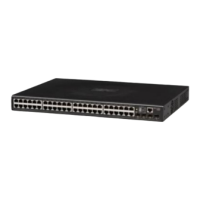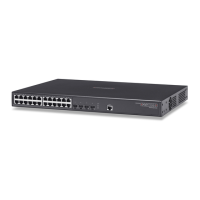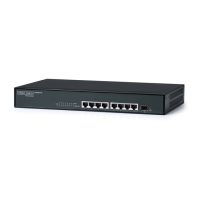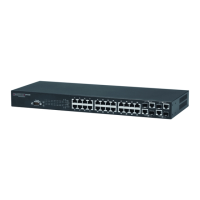Overview of the Command Line Interface
21-10
21
Command Groups
The system commands can be broken down into the functional groups shown below.
Table 21-4 Command Group Index
Command Group Description Page
General Basic commands for entering privileged access mode, restarting the
system, or quitting the CLI
22-1
System Management Display and setting of system information, basic modes of operation,
maximum frame size, file management, console port and telnet
settings, system logs, SMTP alerts, and the system clock
23-1
Simple Network
Management Protocol
Activates authentication failure traps; configures community access
strings, and trap receivers
24-1
User Authentication Configures user names and passwords, logon access using local or
remote authentication, management access through the web server,
Telnet server and Secure Shell; as well as port security, IEEE 802.1X
port access control, and restricted access based on specified IP
addresses
25-1
Access Control List Provides filtering for IPv4 frames (based on address, protocol, TCP/
UDP port number or TCP control code), IPv6 frames (based on
destination address, next header type, or flow label), or non-IP frames
(based on MAC address or Ethernet type)
26-1
Interface Configures the connection parameters for all Ethernet ports,
aggregated links, and VLANs
27-1
Link Aggregation Statically groups multiple ports into a single logical trunk; configures
Link Aggregation Control Protocol for port trunks
28-1
Mirror Port Mirrors data to another port for analysis without affecting the data
passing through or the performance of the monitored port
29-1
Rate Limit Controls the maximum rate for traffic transmitted or received on a port 30-1
Address Table Configures the address table for filtering specified addresses, displays
current entries, clears the table, or sets the aging time
31-1
Spanning Tree Configures Spanning Tree settings for the switch 33-1
VLANs Configures VLAN settings, and defines port membership for VLAN
groups; also enables or configures private VLANs and protocol VLANs
34-1
Class of Service Sets port priority for untagged frames, selects strict priority or weighted
round robin, relative weight for each priority queue, also sets priority for
TCP/UDP traffic types, IP precedence, and DSCP
35-1
Quality of Service Configures Differentiated Services 36-1
Multicast Filtering Configures IGMP multicast filtering, query parameters, and specifies
ports attached to a multicast router
37-1
Domain Name Service Configures DNS services. 38-1
Dynamic Host
Configuration Protocol
Configures DHCP client, relay and server functions 39-1
IP Interface Configures IP address for the switch interfaces; also configures ARP
parameters and static entries
41-1
IP Routing Configures static and dynamic unicast routing 42-1
Router Redundancy Configures router redundancy to create primary and backup routers 40-1

